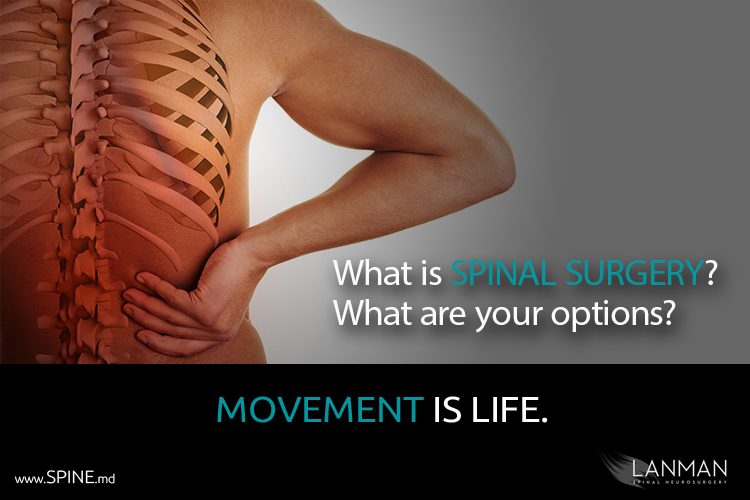Recovery from the four principal types of back surgery – laminectomy, discectomy, spinal fusion, and artificial disc replacement – will vary because each surgical procedure affects the body in different ways. Recovery from these surgical procedures also depends significantly on the extent of damage from spinal conditions such as degenerative disc disease, spinal stenosis, spondylolisthesis, and other disorders of the spine.
Post-Operative Recovery from Back Surgery
Age and physical condition of the patient will often determine the length of time that a patient experiences for post-operative recovery. Specific experiences will also depend upon the procedure performed.
Excluding the healing process after back surgery – which can be 3-4 weeks to up to a full year – most patients go home post-operatively with less pain from their lower back or neck than they had before the back or neck surgery. Spinal fusion produces the longest post-operative recovery period – between 8 months to up to a year. And that’s before the patient can re-engage their normal daily activities.
Total disc replacement (artificial disc surgery), which replaces spinal fusion as the standard for treatment of most common spinal disorders, may require a relatively short recovery period of about 3 weeks to 3 months – given that, like fusion, it is major surgery. Again, however, the actual recovery period experienced by the patient depends on the extent of the operation and the physical condition of the patient.
Medical technology has advanced procedures like laminectomies (which often includes foraminotomy) and discectomies so that they are now relatively short outpatient procedures. Taking into consideration the scope of the procedure and the condition of the patient, post-operative recovery from these procedures may require 1-2 weeks of light activity.
As with all back surgery, patients should observe all of their doctor’s instruction. They should also be mindful that a full recovery is contingent upon the patient’s persistent follow-through with postoperative therapy (e.g., physical therapy, fitness, nutrition, medication). Moreover, patients must always keep their follow-up appointments and report sudden changes in their condition or if the original pain or numbness return.
Recovery from Laminectomy, Foraminotomy Surgeries
Patients who are diagnosed with spinal stenosis have progressive pain that is localized at or near the spine and numbness in extremities such as the arms and hands or legs and feet. “Spinal stenosis” is a gradual narrowing of the nerve channels (otherwise known as the “foramen”). Laminectomies/foraminotomies are performed on any portion of the spine (cervical, thoracic, lumbar) where spinal stenosis is found. Medical technological advancements like microendoscopy allow many surgeons to conduct this procedure on an outpatient basis. The procedure itself may take 1-2 hours to complete. This shortens the expected recovery to about a week or so of home rest. Your doctor may also recommend 1-2 months of limitations –against heavy lifting, bending, stooping, specific sports activities.
Recovery from Discectomy Surgery
Back and neck pain are most often caused when there is damage to a spinal disc or degeneration (herniated disc, degenerative disc disease). The patient may experience localized pain and persistent numbness (tingling) in the extremities (arms, fingers, legs, toes). A surgeon will recommend a discectomy to remove a portion of the herniated spinal disc to relieve nerve compression that is causing the pain and numbness. The best news is that thanks to medical technologies like microendoscopy, discectomies are almost always performed as an outpatient procedure that lasts about 1 to 2 hours. As a result, the patient goes home immediately and may need about 1 week of home recovery before returning to most of their physical activities. Without a doubt, the surgeon will recommend easing back into heavy lifting and specific athletic activities for about 1 to 2 months, depending on the extent of the procedure and the condition and the physical condition of the patient.
Recovery from Spinal Fusion Surgery
Fewer and fewer physicians are recommending fusion as a surgical treatment for degenerative disc disease and other spinal disorders that do not respond to conservative treatments. Like all major surgery, spinal fusion requires great care and planning for the patient. Among the oldest medical procedures still in use today, spinal fusion was developed around the turn of the 20th Century and has been recently superseded by artificial disc replacement surgery. The reason is obvious: fusion seeks to prevent motion where the source of spinal pain and discomfort originates. That means using specialized titanium screws, rods, plates, and other implants to “stabilize” two or more vertebral segments. The surgeon will then “graft” the segments so that the segments become a single solid bony structure. Even with the help of our most advanced medical technology, spinal fusion will take up to 8 hours to complete and result in 6 to 12 months of time-off recovery.
Recovery from Artificial Disc Replacement Surgery
Sometimes when there is massive damage or failure of one or more spinal discs, a surgeon will recommend major surgery. In more cases, surgeons see artificial disc replacement surgery (or total disc replacement) as the best solution for most patients. The goal here is to replace the failed spinal discs with an artificial one that’s made from metal with a semi-flexible biopolymer that imitates the pliability of a natural disc. Artificial disc replacement surgery is a relatively new procedure that was introduced into the United States in 2000 and has since received FDA approval based on numerous favorable clinical trials. The big difference is that post-operatively, patients report full restoration of their range of motion and flexibility. More important, while artificial disc replacement surgery may take up to 2 hours, many patients are in full recovery in 6 weeks, depending on the extent of the surgery and the physical condition of the patient before the surgery.
###







